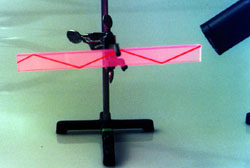Equipment:
- Laser
- Plexiglass light pipes (2 available)

Figure 1: Laser light incident on a plexiglass “pipe”.
Demo:
A laser with a few differently shaped plastic light guides demonstrates how fiber optics works. When laser light is incident on the pipe, it may either be transmitted through to the air outside the pipe (while being refracted away from the normal) or totally internally reflected within the pipe. What happens to the light depends on the incident angle of the laser.
Explanation:
Fiber optics relies on the idea of total internal reflection. It is easy to use this demonstration to exhibit the concept. Fiber optics relies on total internal reflection of to transmit information via light signals. Referring to Figure 1, it’s easy to observe how this may be achieved.
Snell’s law governs the behavior of light incident at a boundary:
Where ,
refer to the indices of refraction of materials 1 and 2 (on opposite sides of the boundary), respectively and
represents the angle the incident light makes with respect to the normal of the boundary, and
is the angle the transmitted light makes with respect to the normal of the boundary.
When the incident angle is sufficiently great, the angle of the transmitted light will be ; i.e., it will lie along the boundary. Once the incident angle moves past this critical angle, light will no longer be transmitted into the second medium. Instead, the light will be reflected back into the initial material. Since the reflected light will be of the same angle measurement as the initial incident angle, it will once again be totally reflected. Hence, the light will continue to “bounce” along the pipe, until it reaches the end.
Written by Madison Harris